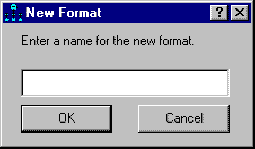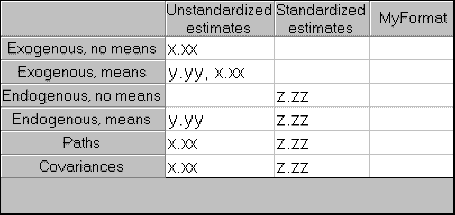IBM® SPSS® Amos™ 28
1.Press  (Menu: View→Interface Properties).
(Menu: View→Interface Properties).
2.Select Formats.
3.Press New Format. (The New Format dialog opens.)

Say you call your new format "MyFormat". Then the New Format dialog then appears as follows.

After you press OK the Formats tab has a new column labeled "MyFormat":

Now you can define the new format by typing templates into the empty spaces in the MyFormat column. A parameter template is a string of one of the following three forms:
x.xx... |
for (unstandardized) variances, covariances, and/or regression weights, |
y.yy... |
for means and intercepts, |
z.zz... |
for R2 values, correlations and standardized regression weights. |
It is necessary to define six templates -- one for each type of path diagram object that can have model parameters associated with it.
Exogenous, no means
When means are not estimated, an exogenous variable only has one parameter associated with it, namely its variance. Here is how various templates would cause a variance of 12.3456789 to be displayed:
Template |
Result |
Comment |
x.xx |
12.35 |
two places to the right of the decimal point |
x.xxxxx |
12.34568 |
five places to the right of the decimal point |
[x.xx] |
[12.35] |
characters other than "x", "y", "z" and "." are copied from the template |
x.xx* |
12.35* |
|
Exogenous, means
When means are estimated, an exogenous variable has two parameters associated with it: its mean and variance. Here is how various templates would cause a mean of 1.11111111 and a variance of 22.22222222 to be displayed:
Template |
Result |
Comment |
x.xx, y.yyy |
1.11, 22.222 |
|
y.yyy, x.xx |
22.222, 1.11 |
|
x.xx |
1.11 |
the variance is not displayed |
y.yyy |
2.222 |
the mean is not displayed |
Endogenous, no means
"No means" is shorthand for "no means and no intercepts". When means and intercepts are not estimated, an endogenous variable has no parameters associated with it. However, Amos can display a squared multiple correlation for an endogenous variable if you have requested squared multiple correlations on the Output tab of the  window. Here is how various templates would cause a squared multiple correlation of .123456789 to be displayed:
window. Here is how various templates would cause a squared multiple correlation of .123456789 to be displayed:
Template |
Result |
z.zz |
.12 |
z.zzz |
.123 |
Endogenous, means
"Means" is shorthand for "means and intercepts". If means and intercepts are estimated, each endogenous variable is associated with a single intercept, which Amos can display on a path diagram. In addition, Amos can display a squared multiple correlation for an endogenous variable if you have requested squared multiple correlations on the Output tab of the  window. Here is how various templates would cause an intercept of 11.11111111 and a squared multiple correlation of .22222222 to be displayed:
window. Here is how various templates would cause an intercept of 11.11111111 and a squared multiple correlation of .22222222 to be displayed:
Template |
Result |
y.yy, z.zz |
11.11, .22 |
z.zz, y.yy |
.22, 11.11 |
y.yy |
11.11 |
z.zz |
.22 |
Paths
Each path (single-headed arrow) is associated with a regression weight, and possibly a standardized regression weight if you have requested standardized estimates on the Output tab of the  window. Here is how various templates would cause a regression weight of 11.1111111 to be displayed, supposing that the same regression weight is .22222222 after standardizing all variables:
window. Here is how various templates would cause a regression weight of 11.1111111 to be displayed, supposing that the same regression weight is .22222222 after standardizing all variables:
Template |
Result |
x.xxx, z.zz |
11.111, .22 |
z.zzz, x.xx |
.222, 11.11 |
x.xxx (z.zz) |
11.111 (.22) |
.zzz** |
.222** |
Covariances
Each covariance object (double-headed arrow) is associated with a covariance, and possibly a correlation (if you have requested standardized estimates on the Output tab of the  window.) Here is how various templates would cause a covariance of 11.1111111 to be displayed, supposing that the corresponding correlation is .22222222:
window.) Here is how various templates would cause a covariance of 11.1111111 to be displayed, supposing that the corresponding correlation is .22222222:
Template |
Result |
x.xxx, z.zz |
11.111, .22 |
z.zzz, x.xx |
.222, 11.11 |
x.xxx (z.zz) |
11.111 (.22) |
.zzz** |
.222** |
Leaving a template blank
No values will be displayed for a path diagram object that has a blank template. The "Standardized estimates" format, for example, has two blank templates.
Overriding a format
The formats defined on the Formats tab are global -- they affect all parameters. You can use the Format tab of the  window to override the global formats for an individual parameter.
window to override the global formats for an individual parameter.